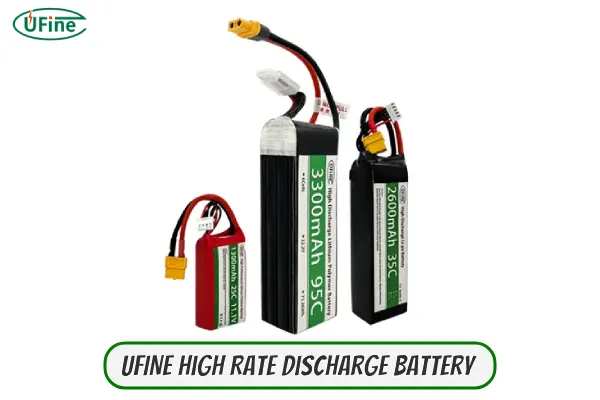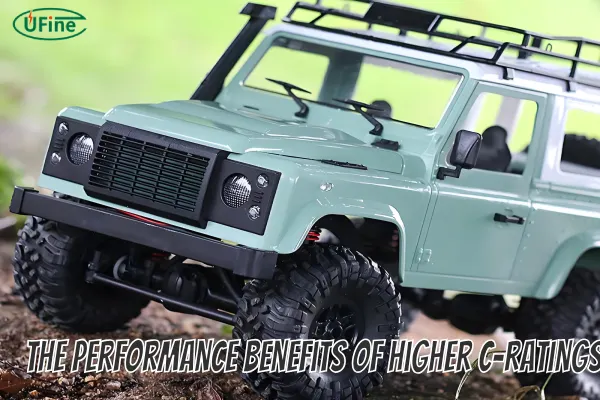
- Part 1. Understanding C-rating
- Part 2. The impact of C-rating on RC performanc
- Part 3. The risks of exceeding C-rating limits
- Part 4. Where to find the C-rating
- Part 5. Matching C-Rating to your RC needs
- Part 6. The performance benefits of higher C-ratings
- Part 7. The performance drawbacks of higher C-ratings
- Part 8. How do I know what discharge C rating my RC uses?
- Part 9. Conclusion
The allure of speed and power is a driving force behind the RC hobby. Central to achieving these performance benchmarks is the battery, a critical component that fuels the excitement. A key parameter influencing a battery’s performance is the C-rating, a numerical value that encapsulates its discharge capability. While a higher C-rating often equates to increased power, the relationship between C-rating and performance is more complex than it might seem. Let’s delve into the intricacies of C-ratings to unravel the power behind your RC battery.
Part 1. Understanding C-rating
The C-rating, a number typically printed on the battery’s label, serves as a quantitative measure of a battery’s ability to deliver current. Essentially, it represents the maximum continuous discharge current relative to the battery’s capacity. For instance, a 50C battery can theoretically output 50 times its capacity in one hour. A 5000mAh 50C battery, therefore, has the potential to deliver a burst of 250 amps.
It’s crucial to approach these figures with a degree of caution. While theoretically possible, achieving the maximum C-rating in real-world conditions is often hindered by factors such as internal resistance and temperature. Moreover, consistently drawing the maximum current can adversely affect battery life and safety.
Part 2. The impact of C-rating on RC performanc
A higher C-rating typically translates to enhanced performance in RC vehicles, particularly those demanding high current bursts, such as racing cars or acrobatic drones. By providing a more substantial current output, a high C-rating battery can deliver:
-
Accelerated acceleration: Quicker launch times and improved responsiveness.
-
Enhanced climbing ability: Increased torque for navigating steep inclines and rough terrain.
-
Improved throttle response: Sharper and more immediate reactions to control inputs.
These performance gains are particularly noticeable in applications that require rapid bursts of power, where the battery’s ability to deliver high current is paramount. However, it’s essential to recognize that a higher C-rating is just one piece of the performance puzzle. Factors such as motor efficiency, gearing, and overall vehicle setup also significantly influence the vehicle’s capabilities.
Part 3. The risks of exceeding C-rating limits
While the allure of higher speeds and quicker acceleration is undeniable, pushing a battery beyond its recommended C-rating can lead to severe consequences. Exceeding the battery’s discharge limits can result in:
-
Overheating: Excessive current draw generates heat, which can rapidly increase the battery’s internal temperature. Overheating can damage the battery’s internal chemistry, leading to reduced capacity, swelling, or, in extreme cases, thermal runaway.
-
Reduced Battery Lifespan: Continuously operating a battery at its maximum discharge rate accelerates capacity fade, diminishing the battery’s ability to hold a charge over time. This results in shorter run times and increased charging frequency.
-
Motor and ESC Stress: If the battery can deliver more current than the motor and electronic speed controller (ESC) can handle, it can lead to component failure. Excessive heat generated by the motor and ESC can damage their internal components, requiring costly repairs.
Part 4. Where to find the C-rating
Locating the C-rating on your RC battery is relatively straightforward. It’s typically printed on the battery’s label or packaging. Look for a number followed by the letter “C.” For instance, a “50C” rating indicates a maximum discharge rate of 50 times the battery’s capacity.
Part 5. Matching C-Rating to your RC needs
Selecting the appropriate C-rating for your RC vehicle is crucial for optimal performance and battery longevity. Several factors should be considered:
-
Vehicle type and intended use: High-performance vehicles like racing cars and drones often benefit from higher C-rating batteries, while casual or off-road vehicles may require lower C-ratings.
-
Motor and ESC specifications: Ensure the battery’s C-rating is compatible with the motor and ESC’s current handling capabilities to prevent damage.
-
Battery capacity: A higher capacity battery often comes with a lower C-rating. Balancing capacity and discharge rate is essential for specific applications.
-
Driving style: Aggressive driving styles that demand frequent high-current bursts may necessitate a higher C-rating battery.
It’s prudent to start with a slightly lower C-rating than the maximum recommended by the vehicle manufacturer. This approach provides a safety margin and allows for gradual experimentation to determine the optimal C-rating for your specific setup.
Part 6. The performance benefits of higher C-ratings
Beyond the aforementioned advantages, higher C-rating batteries can offer additional benefits:
-
Consistent power delivery: Minimizes voltage sag under load, ensuring consistent performance.
-
Extended peak power duration: Maintains high power output for longer periods, essential for sustained high-performance maneuvers.
-
Improved efficiency: By reducing voltage sag, higher C-rating batteries can improve motor efficiency and overall system performance.
However, it’s important to note that these benefits are contingent upon the vehicle’s ability to utilize the increased power output effectively. Oversizing the battery without corresponding upgrades to the motor, ESC, or gearing may not yield significant performance gains.
Part 7. The performance drawbacks of higher C-ratings
While offering performance advantages, high C-rating batteries come with certain drawbacks:
-
Increased cost: Batteries with higher C-ratings generally command a premium price due to the advanced technology and materials involved.
-
Increased weight: Higher C-rating batteries tend to be heavier than their lower C-rating counterparts, which can impact vehicle performance in some cases.
-
Reduced lifespan: Aggressive use of high C-rating batteries can accelerate battery degradation, resulting in a shorter lifespan.
-
Potential for instability: In certain conditions, high C-rating batteries may exhibit instability, leading to erratic performance or safety concerns.
Part 8. How do I know what discharge C rating my RC uses?
Determining the optimal C-rating for your RC vehicle can be challenging. While the battery’s label will provide a C-rating, understanding how it relates to your specific setup is crucial.
Understanding the C-Rating: Recall that the C-rating indicates the maximum continuous discharge rate a battery can handle. A higher C-rating means it can deliver more current. However, this doesn’t necessarily mean you need the highest C-rating available.
Matching C-Rating to Your RC: The ideal C-rating depends on several factors:
-
Vehicle type and intended use: High-performance vehicles like racing cars and drones often demand higher C-ratings. Less demanding models can operate with lower C-rating batteries.
-
Motor and ESC specifications: Consult your vehicle’s manual to determine the recommended or maximum C-rating for your motor and ESC. Exceeding these limits can lead to damage.
-
Battery capacity: Larger capacity batteries often have lower C-ratings. Balancing capacity and discharge rate is essential.
Real-world Considerations: While the C-rating provides a theoretical maximum, real-world performance can vary. Factors like battery temperature, age, and charging habits can influence the actual discharge capability.
Starting Point: If unsure, begin with a slightly lower C-rating than recommended. You can always upgrade if needed. Overestimating the required C-rating can lead to unnecessary costs and potential damage.
Experimentation: With caution, you can experiment to find the optimal C-rating for your setup. However, always prioritize safety and monitor your equipment closely.
By carefully considering these factors and conducting thorough research, you can select the appropriate C-rating for your RC vehicle, ensuring optimal performance and battery longevity.
Remember, the goal is to match the battery’s capabilities to your vehicle’s demands without compromising safety or battery life.
Part 9. Conclusion
The C-rating of an RC battery is a critical factor influencing performance, but it’s essential to approach it with a balanced perspective. While a higher C-rating can offer performance advantages, it’s crucial to consider the potential risks and match the battery to your specific needs. By understanding the intricacies of C-ratings and making informed choices, you can optimize your RC experience while safeguarding your investment.
Remember, the ideal C-rating is a compromise between performance and longevity. Prioritize safety and the overall health of your battery system to ensure a long and enjoyable RC experience.
Related Tags:
More Articles

What is the Difference Between Silver Zinc Battery vs. Lithium-ion Rechargeable?
Compare silver zinc and lithium-ion rechargeable batteries: energy density, cycle life, safety, cost, and uses in drones, medical devices, EVs, and electronics.
What are Watts and Watt Hours in Battery?
Understand watt vs watt-hour in batteries: key differences, how to calculate capacity, and why they matter. Includes free comparison table.
Best 10 Blood Pressure Monitor Battery Review: Finding the Most Reliable
Are you looking for a reliable Blood Pressure Monitor battery? Here is a complete guide with the top 10 best blood pressure monitor batteries.
Bluetooth Headphone Battery Guide: All You Need to Know
Maximize headphone battery life with expert tips! Learn how to charge, check, troubleshoot, and choose the best bluetooth headphone battery in 2025.
LiFePO4 Battery VS. Lithium-ion Polymer Battery: Which One Is Best?
Comprehensive comparison of LiFePO4 vs Lithium Ion Polymer batteries: energy density, safety, lifespan, cost. Find out which battery suits your needs in 2025.







